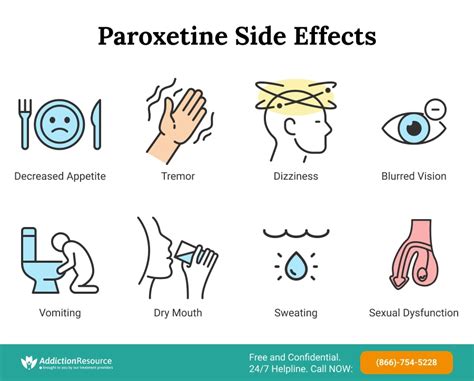Intro
Discover Paroxetine side effects, including withdrawal symptoms, serotonin syndrome, and antidepressant interactions, to ensure safe usage and minimize risks of this SSRI medication.
Paroxetine, commonly known by its brand name Paxil, is a selective serotonin reuptake inhibitor (SSRI) used to treat various mental health conditions, including depression, anxiety disorders, obsessive-compulsive disorder (OCD), and post-traumatic stress disorder (PTSD). While paroxetine can be an effective treatment for these conditions, it is not without its side effects. Understanding the potential side effects of paroxetine is crucial for individuals considering this medication and for those who are already taking it.
The importance of being informed about paroxetine side effects cannot be overstated. Side effects can range from mild and temporary to severe and long-lasting. In some cases, they can significantly impact an individual's quality of life, leading to discomfort, distress, and potentially affecting adherence to the prescribed treatment regimen. Furthermore, being aware of the possible side effects can help individuals and their healthcare providers make informed decisions about whether paroxetine is the right choice for their specific needs.
Paroxetine, like other SSRIs, works by increasing the levels of serotonin in the brain, which helps improve mood, reduce anxiety, and alleviate other symptoms associated with mental health conditions. However, this alteration in brain chemistry can also lead to a variety of side effects. Common side effects of paroxetine include nausea, headache, drowsiness, and dry mouth. While these effects are generally mild and may diminish over time, they can still cause significant distress for some individuals. It is also important to note that paroxetine can have more serious side effects, and understanding these potential risks is essential for safe and effective treatment.
Common Side Effects of Paroxetine

Less Common but Serious Side Effects

Managing Side Effects
Managing the side effects of paroxetine often involves working closely with a healthcare provider to find the right balance between therapeutic benefits and tolerable side effects. This may involve adjusting the dosage, switching to a different medication, or adding another medication to counteract specific side effects. Lifestyle changes, such as regular exercise, a healthy diet, and sufficient sleep, can also help mitigate some side effects.Long-Term Side Effects and Withdrawal

Withdrawal from paroxetine can occur when the medication is stopped abruptly or the dosage is significantly reduced. Symptoms of withdrawal can include dizziness, headache, nausea, irritability, and flu-like symptoms. It is crucial to taper off paroxetine under the guidance of a healthcare provider to minimize the risk of withdrawal symptoms.
Special Considerations
Certain individuals may be at a higher risk for side effects from paroxetine, including: - Pregnant or breastfeeding women, as paroxetine can pass to the baby and cause side effects - Children and adolescents, due to the increased risk of suicidal thoughts and behaviors - Older adults, who may be more sensitive to the effects of paroxetine and experience more side effects - Individuals with certain medical conditions, such as liver or kidney disease, which can affect how the body processes paroxetineInteractions with Other Medications

Monitoring and Follow-Up
Regular monitoring and follow-up appointments with a healthcare provider are crucial when taking paroxetine. These visits allow for the assessment of the medication's effectiveness, the management of side effects, and adjustments to the treatment plan as needed. Individuals taking paroxetine should be vigilant about reporting any changes in their condition or the occurrence of side effects.Conclusion and Next Steps

We invite you to share your thoughts and experiences with paroxetine in the comments below. Your insights can help others better understand the potential benefits and risks of this medication. Additionally, if you have questions or concerns about paroxetine or any other mental health topic, please do not hesitate to reach out. Together, we can promote a better understanding of mental health and support those seeking help.
What are the most common side effects of paroxetine?
+The most common side effects of paroxetine include nausea, headache, drowsiness, and dry mouth. These side effects are generally mild and may diminish over time.
Can paroxetine cause serious side effects?
+Yes, paroxetine can cause serious side effects, including suicidal thoughts or behaviors, serotonin syndrome, and allergic reactions. It is essential to seek immediate medical attention if any of these symptoms occur.
How can I manage the side effects of paroxetine?
+Managing the side effects of paroxetine often involves working closely with a healthcare provider to find the right balance between therapeutic benefits and tolerable side effects. This may involve adjusting the dosage, switching to a different medication, or adding another medication to counteract specific side effects.
Can I stop taking paroxetine at any time?
+No, it is not recommended to stop taking paroxetine abruptly. Stopping the medication suddenly can lead to withdrawal symptoms. It is crucial to taper off paroxetine under the guidance of a healthcare provider to minimize the risk of withdrawal symptoms.
Are there any special considerations for taking paroxetine?
+Yes, certain individuals may be at a higher risk for side effects from paroxetine, including pregnant or breastfeeding women, children and adolescents, older adults, and individuals with certain medical conditions. It is essential to discuss these considerations with a healthcare provider before starting paroxetine.
